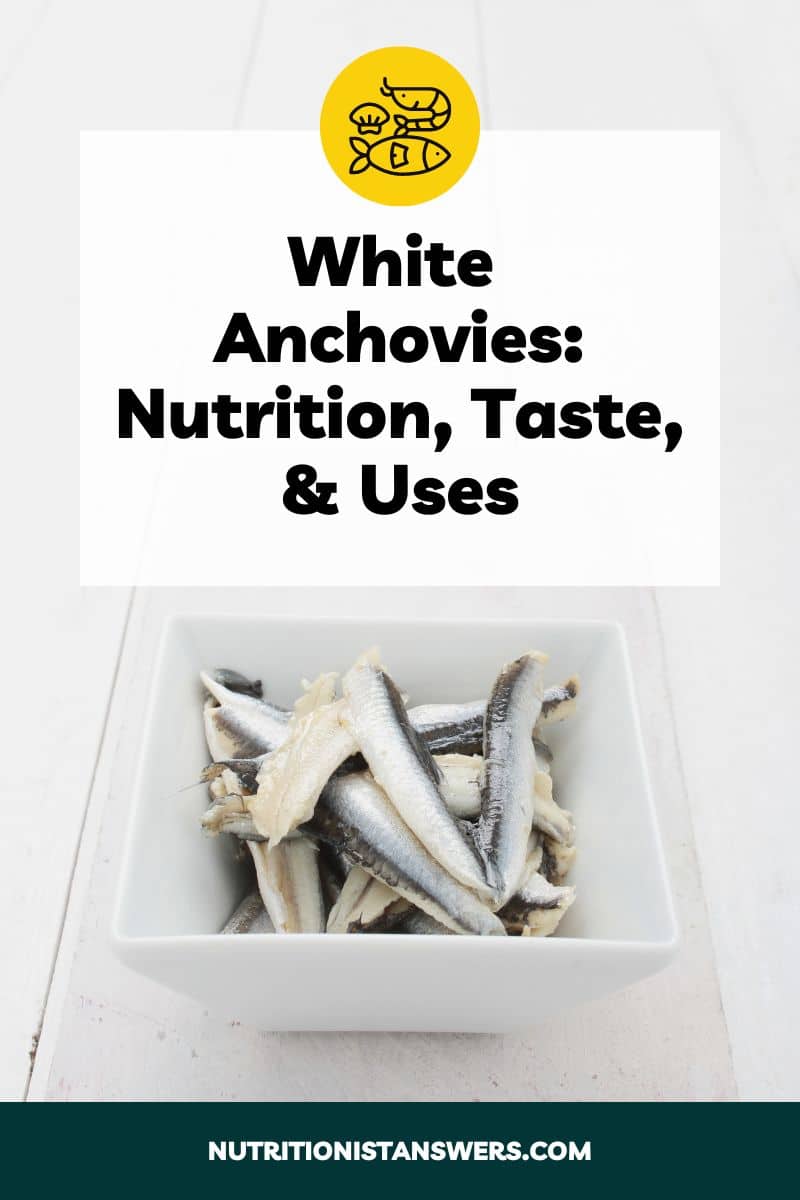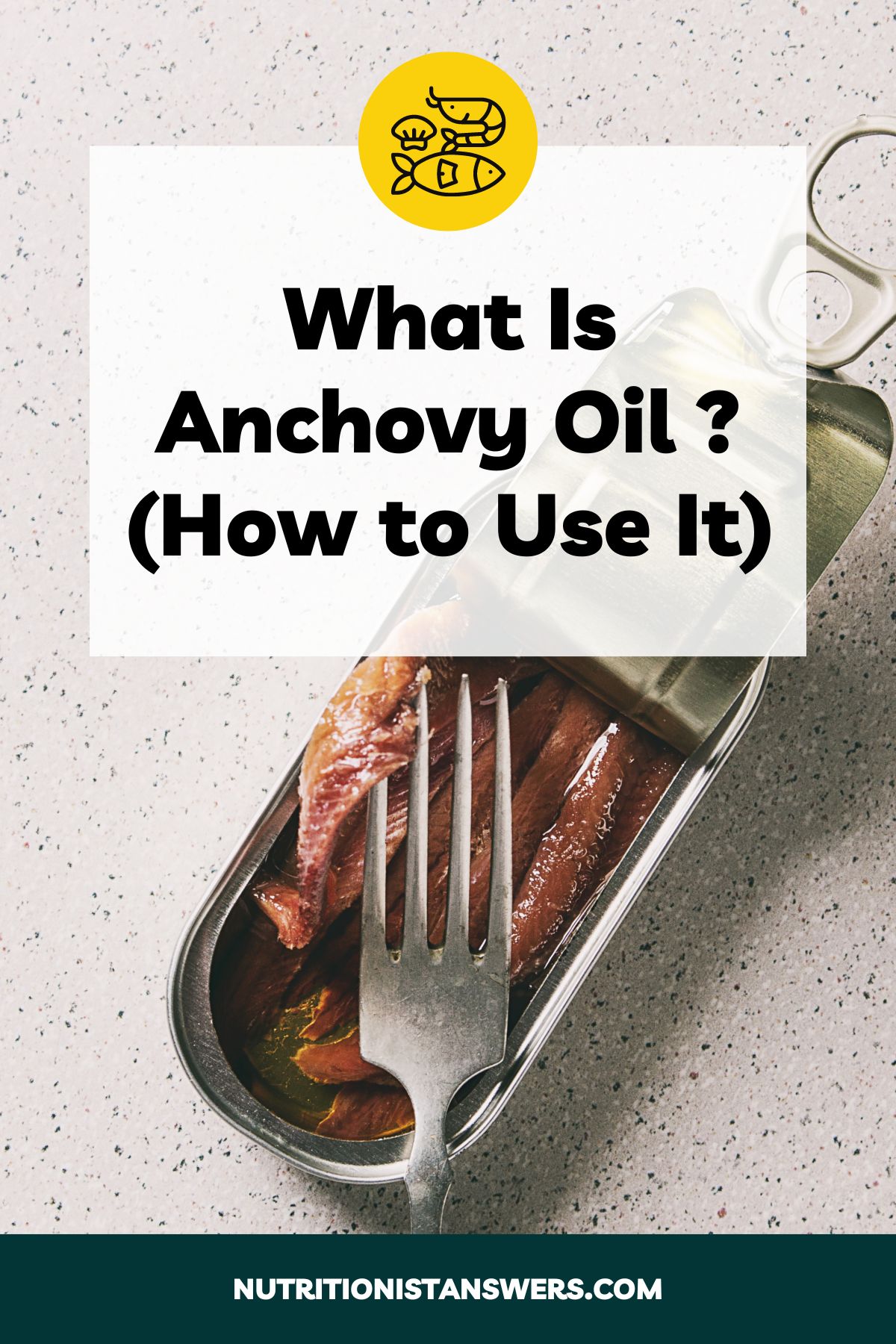Have you ever seen white anchovies at the grocery store and wondered what they are?
Turns out, anchovies can be prepared in multiple ways.
White anchovies are uncured, while brown anchovies (the type you usually buy in a can or jar) are cured in salt before packing, which changes their color from white to brown.
In this article, we delve into the world of white anchovies, exploring their unique taste, nutritional benefits, and versatile uses in the kitchen.

Please note that this article contains affiliate links. If you click one of these links and make a purchase, we may earn a commission. As an Amazon Associate, we earn from qualifying purchases.
What are white anchovies?
White anchovies are anchovies that haven’t been cured with salt, so their flesh retains its original white color and milder flavor.
Typically, the anchovies you’ll find at the grocery store have been cured, giving them a deeper, more intense flavor and a darker, pinkish-brown color.
White anchovies, on the other hand, undergo less processing. Instead of being cured, they are often fileted and soaked in vinegar, then removed and rinsed before being packed in olive oil.
What do white anchovies taste like?
White anchovies have a delicate flavor that’s fishy, slightly sweet, and barely briny. Compared to brown (cured) anchovies, they are milder and much less salty.
The texture of white anchovies is firm but still flaky and easy to chew. Unlike brown anchovies, they do not “melt” or disintegrate when cooked or blended into sauces.
White anchovies nutrition
White anchovies are high in protein with a moderate amount of calories and fat, and they contain no carbohydrates or fiber.
Here’s a more detailed breakdown of white anchovy nutrition:
Calories and macronutrients
Here’s the calorie and macronutrient content for a 3-ounce (85-gram) serving of white anchovies packed in olive oil (1):
- Calories: 160
- Carbohydrates: 0 grams
- Fiber: 0 grams
- Protein: 19 grams
- Fat: 5 grams
The nutrition of white anchovies is slightly different from brown (cured) anchovies. Here’s a comparison of the calorie & macronutrient content of white anchovies vs brown anchovies:
| Nutrient | White anchovies, packed in oil (3 ounces, 85 grams) (1) | Brown (cured) anchovies, canned in oil (3 ounces, 85 grams) (2) |
| Calories | 160 | 179 |
| Carbohydrates | 0 grams | 0 grams |
| Protein | 19 grams | 25 grams |
| Fat | 10 grams | 8 grams |
White anchovies are lower in calories and protein but higher in fat than brown (cured anchovies).
Around 25% of the fat in anchovies is in the form of omega-3 fatty acids, a type of fat that lowers inflammation and may reduce the risk of heart disease, cancer, and arthritis (3, 4).
It’s likely that the different processing methods are responsible for the variations in nutrition between white anchovies and brown anchovies.
Vitamins and minerals
Here’s the vitamin and mineral content for white anchovies, based on a 3-ounce (85-gram) serving size (1):
- Calcium: 200 mg (15% DV)
- Iron: 1.4 mg (8% DV)
- Potassium: 245 mg (5% DV)
- Sodium: 370 mg (16% DV)
- Vitamin D: 8 IU (27% DV)
As you can see, white anchovies are high in Vitamin D, sodium, calcium, and iron, while providing a small amount of potassium.
Canned versions of fish, including anchovies, are often high in calcium because many products include the bones. The canning process softens the bones, making them safe to consume.
Although they’re still a high-sodium food, white anchovies are close to 90% lower in sodium than brown (cured) anchovies, because they’re not cured (2).
Where to buy white anchovies
White anchovies are less common than brown (cured) anchovies and can be difficult to find.
Fresh white anchovies are rarely available, but canned versions are sometimes available at health food markets and specialty grocery stores.
Another option is to purchase canned white anchovies online. Here are some of the most popular white anchovy products you can buy on Amazon:
- Patagonia Provisions Lemon Olive Spanish White Anchovies
- Wild Planet Wild White Anchovies in Extra Virgin Olive Oil
- Wild Planet Wild White Anchovies in Water with Sea Salt
- Fruits de Mer White Anchovies Marinated in Sunflower Oil
- Agostino Recca Italian White Anchovies
How to store white anchovies
Fresh, raw white anchovies should be cooked promptly because they only last 1-2 days in the refrigerator. After cooking, they can be kept in the fridge for 3-4 days (5).
Canned white anchovies are shelf-stable until opened. After opening, you can store canned white anchovies in the refrigerator for 3-4 days.
Ways to use white anchovies
As an appetizer
White anchovies have a delicate flavor that can elevate the simplest of appetizers. They can be served on their own with a splash of lemon juice, or paired with crackers or crostini.
For a simple appetizer, spread a thin layer of cream cheese onto your cracker, then layer a white anchovy across the top. Drizzle with a touch of olive oil, sprinkle with chopped fresh herbs such as parsley or thyme, and finish with a squeeze of lemon.
For a lighter, dairy-free version, layer white anchovy on top of chopped tomatoes and onions tossed with extra-virgin olive oil and balsamic vinegar, and sprinkle with fresh minced basil.
In salads and pasta dishes
White anchovies can be an excellent way to add extra protein and a delightful savory flavor to your favorite salads and pasta dishes.
For salads, layer white anchovies over a classic Caesar salad for an unexpected twist, or toss them with mixed greens, cherry tomatoes, olives, and a light vinaigrette for a Mediterranean flair.
In pasta dishes, white anchovies can be sautéed with garlic, capers, and chili flakes, then tossed with spaghetti, roasted tomatoes, and kalamata olives for a quick, flavorful weeknight dinner.
On pizzas and flatbreads
White anchovies can bring a delicious briny, fishy flavor to pizzas and flatbreads. They complement a wide range of toppings, especially those with a Mediterranean influence.
For a classic pizza, layer white anchovies over fresh mozzarella and tomato slices, then top with fresh herbs such as basil and oregano.
For a Mediterranean flatbread, spread a layer of hummus onto the dough and top with chopped tomatoes, feta cheese, olives, and white anchovies. Drizzle with olive oil before baking.
Final thoughts
White anchovies have a milder, more delicate flavor and firmer texture than brown (cured) anchovies because they haven’t been cured with salt.
Nutritionally, white anchovies are high in protein and anti-inflammatory omega-3 fats. They are also rich sources of vitamin D, and canned versions (with bones) are high in calcium.
While they can be difficult to find, white anchovies are worth trying for their delicious flavor and nutritional value. You can buy them online or look for them at specialty grocery stores.
Amy Richter is a Registered Dietitian Nutritionist based in Missouri. She is an experienced nutrition writer and medical advisor for Healthline and Medical News Today. Amy is passionate about all things food-related and enjoys translating complex science into easy-to-understand articles.




